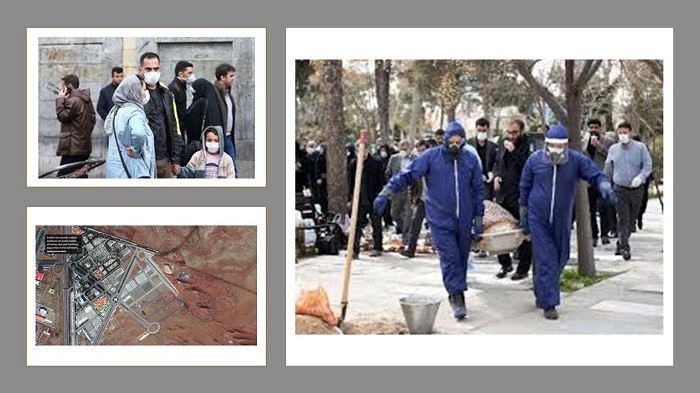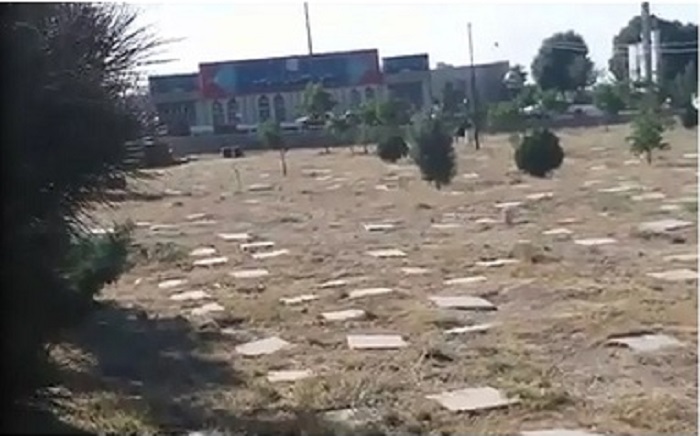
People are being killed in Iran due to coronavirus.
The Iranian regime began digging mass graves in a cemetery outside of Qom two days after it reported its first cases of COVID-19, according to satellite images obtained by the Washington Post.
The images confirm earlier reports from the MEK Iran that the regime knew about the coronavirus outbreak for weeks before reporting its first cases on February 19 and that it is underreporting deaths.

Satellite images obtained by the Washington Post from a cemetery in Qom
False Reports
As of March 13, 2020, the Iranian regime has reported 10,075 confirmed cases of coronavirus and 429 deaths to the World Health Organization (WHO). It has also reported that 3,276 patients have recovered from the virus, the highest number of reported recoveries outside of China, which recorded its first case in late December and has since reported 80,797 more. Iran is the only country to report spikes in recoveries at the same time as spikes in new cases. Iran is also the only country with confirmed deaths that have not reported a single critical case.
Numerous sources in Iran attribute these statistics to the release of actively infected patients from overcrowded hospitals, failure to diagnose coronavirus, and falsification of a cause of death on death certificates.
Coronavirus Deaths
On Thursday, March 12, the MEK Iran announced that the Coronavirus has spread to 160 cities, causing at least 3,650 deaths. These numbers reflect only the deaths that could be confirmed through hospital records, family members, or credible sources such as death certificates, so the number is likely to be much higher. Eyewitnesses report that hundreds of more deaths occurred after the announcement was made.
Poor medical cares lead to losing many lives in #Iranhttps://t.co/Ce8uEzYbQ7#MEK #FreeIran2020 @USAdarFarsi #CoronaVirusUpdate pic.twitter.com/nyEVcGr7nU
— MEK Iran (Mujahedin-e Khalq) (@MEK_Iran) March 12, 2020
Satellite Images of Mass Graves
The coronavirus outbreak in Qom was detected in late January, according to a member of Majlis (regime Parliament), but the government kept the information secret until February 19, two days before the Majlis elections. Government officials had hoped that high voter turnout would restore some semblance of legitimacy to a regime teetering on the verge of the overthrow, and they feared that news of the outbreak would further suppress participation by Iranians who were considering an election boycott.
On February 19, the death toll in Qom had risen to at least 50, and the news could no longer be suppressed. The regime reported two cases to the WHO and then changed the status of the reports to deaths within hours.
On February 21, two days after the regime reported its first cases, satellite images provided by Maxar Technologies, a U.S.-based space technology company, showed new excavation in a previously vacant section of the Behesht-e Masoumeh cemetery in Qom. On February 27, two long trenches, totaling 100 yards in length, were visible, and excavation was still in progress.
The Washington Post article cited the expertise of a senior imagery analyst from Maxar Technologies, writing that “the size of the trenches and the speed with which they were excavated together mark a clear departure from past burial practices involving individual and family plots at the site.”
The imagery analyst also detected a large pile of lime in one of the satellite images, which is sometimes used to mask odor in mass graves. Regime health officials have recently acknowledged using lime when burying coronavirus victims.
More recent satellite images show a flurry of activity at the mass gravesites, with multiple vehicles parked near the trenches. Videos shared on social media provide a closer look at the cemetery.
A video posted on March 3 was shot inside Behesht-e Masoumeh cemetery and transcribed in the Post article:
“‘A worker told me that they must have buried more than 250 coronavirus victims so far,’ the caption reads. As the narrator walks across the cemetery grounds, he points the camera down to highlight what he says are new burials. ‘These are all graves and they are fresh,’ he says, at one point using a gloved index finger to direct the viewer to the plots on the horizon. ‘These are all from the last few days,’ he continues. ‘And as you can see, it goes on until the end.’”
According to a statement from the National Council of Resistance of Iran (NCRI), more mass graves are yet to come. The governor of the city of Khaf, Khorasan Razavi Province, has ordered its mayor to dig dozens of four meter deep graves so that the Coronavirus victims may be buried together.
A History of Mass Graves
It must be noted that the regime has a history of burying the victims of its cruelty in hastily excavated mass graves. 30,000 MEK Iran members were executed over the course of a single summer during the 1988 Massacre and buried in unmarked mass graves. They were not counted, and the locations of their bodies have never been revealed to their families. The regime has bulldozed, paved over, and constructed buildings on top of many of these graves in an effort to conceal this crime against humanity for which it has never faced consequences.

Mass graves of MEK’s members and supporters killed in the 1988 massacre by the Iranian regime
Thousands are dying in Iran due to corruption, incompetence, and neglect, and the regime is once again struggling to bury its victims more quickly than it kills them. The Iranian people need our help. Mrs. Maryam Rajavi, President-elect of the NCRI, has called on the international community to send aid directly to the Iranian people. The regime will squander any donations it receives, but the people of Iran are in desperate need of assistance.
